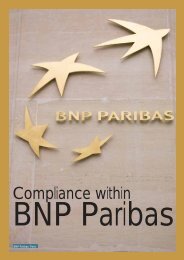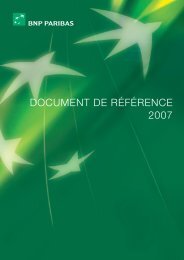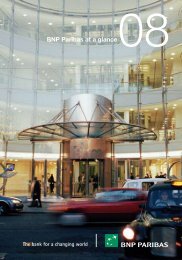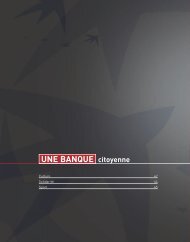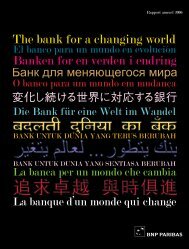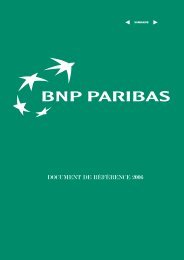2007 REGISTRATION DOCUMENT
2007 REGISTRATION DOCUMENT
2007 REGISTRATION DOCUMENT
- No tags were found...
Create successful ePaper yourself
Turn your PDF publications into a flip-book with our unique Google optimized e-Paper software.
3 RiskRISK MANAGEMENTmitigation techniques< Contents >Insurance policies are subscribed based on the Group’s known claimsexperience, industry benchmarks and the global insurance andreinsurance market capacity.Some business units may take out local insurance policies appropriate totheir own specific activities, or if adequate coverage cannot be obtainedon the French market.The insurance market in <strong>2007</strong> continued to evolve in line with trendsobserved in the previous year, allowing the Group to maintain its highquality,extensive coverage.In selecting insurers, the Group pays close attention to the credit ratingand claims paying ability of the companies concerned.Detailed information on risks incurred by BNP Paribas as well as riskassessment visits, enable insurers to assess the quality of coverage andrisk prevention within the Group, as well as the safeguard measuresput in place and upgraded on a regular basis in light of new standardsand regulations.12ASSET-L IABILITY M ANAGEMENT R ISK3OVERALL INTEREST RATE RISKThe Bank’s strategy for managing overall interest rate risk is based onclosely monitoring the sensitivity of the Bank’s earnings to changes ininterest rates. In this way, it can determine how to achieve an optimumlevel of offset between different risks. This procedure requires anextremely accurate assessment of the risks incurred so that the Bankcan determine the most appropriate hedging strategy, after taking intoaccount the effects of netting the different types of risk.These hedging strategies are defined and implemented for eachportfolio and currency. The “euro customer banking book” concentratesthe majority of BNP Paribas’ overall interest rate risk. In <strong>2007</strong>, thisportfolio saw a widening imbalance between fixed-rate customer loanoriginations and inflows of long-term deposits. Over the year, the fallin outflows on home savings plans in France slowed, while currentaccounts continued to advance. This helped offset the fall in passbooksavings inflows triggered by customers moving savings to higher-yieldingterm deposits. Overall, deposits registered a year-on-year rise comparedwith 2006. In parallel, new medium- and long-term customer loanscontinued to advance across retail networks in France and Italy as well asin specialised subsidiaries, with all products benefiting from this growthmomentum.<strong>2007</strong> can best be analysed as two sharply distinct periods. In the sixmonths to 30 June <strong>2007</strong>, euro and dollar rates rose amid mountinginflationary concerns. The onset of the financial crisis in the summerresulted in significant adjustments to growth forecasts, particularly inthe US, driving down medium- and long-term rates. At the same time, aliquidity squeeze fuelled a sudden sharp rise in short-term rates, requiringincreased oversight of basis risks between the different indexes.The hedges put in place by the Bank in <strong>2007</strong> mainly reflected a fixedrateborrowing strategy. They include derivatives and options typicallyaccounted for as fair value hedges (in accordance with EU carve-outregulations) or cash flow hedges. Government securities are mostlyrecorded in the “Available for sale” category.No hedging relationship was disqualified from hedge accounting in<strong>2007</strong>.STRUCTURAL CURRENCY RISKCurrency hedges are contracted by the Group’s ALM department inrespect of the Group’s investments in foreign currencies and its futureforeign currency revenues. Each hedging relationship is formallydocumented at inception. The documentation describes the hedgingstrategy; identifies the hedged item and the hedging instrument, andthe nature of the hedged risk; and describes the methodology used totest the expected (prospective) and actual (retrospective) effectivenessof the hedge.A hedging relationship is applied and documented for investmentsfinanced by foreign currency loans so that impacts of movements inexchange rates can be recorded in a symmetrical fashion and have noimpact on the profit and loss account. These instruments are designatedas net investment hedges.A similar hedging relationship is set up to hedge the currency risk on netforeign currency assets of consolidated subsidiaries and branches. Fairvalue hedges are used to hedge the currency risk on equity investmentsin non-consolidated companies.No hedging relationship was disqualified from hedge accounting in<strong>2007</strong>.The Group hedges the variability of components of BNP Paribas’ earnings,in particular the highly-probable future revenue streams (mainly interestincome and fees) denominated in currencies other than the eurogenerated by the Group’s main businesses, subsidiaries or branches.In <strong>2007</strong>, no hedges of forecast transactions were disqualified on thegrounds that the related future event was no longer highly probable.456789101184<strong>2007</strong> Registration document - BNP PARIBAS



